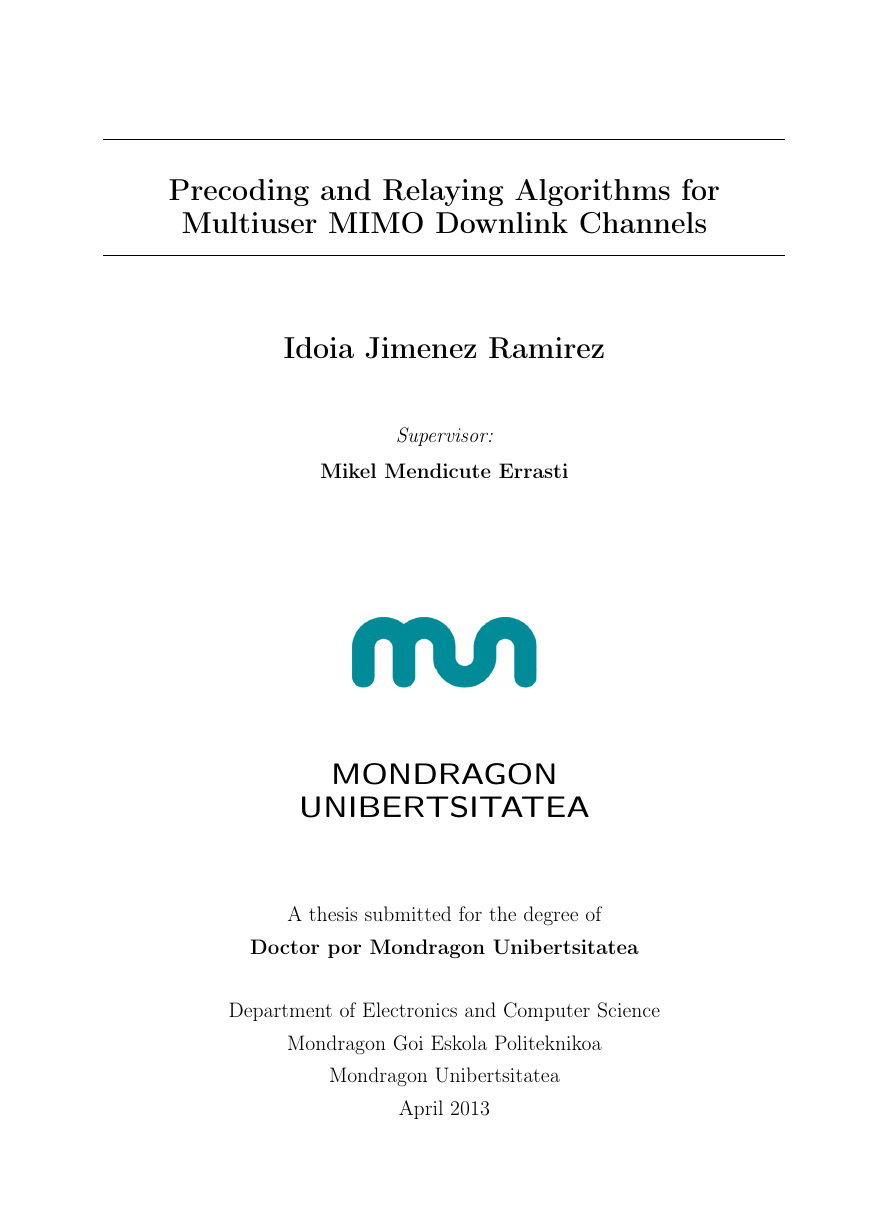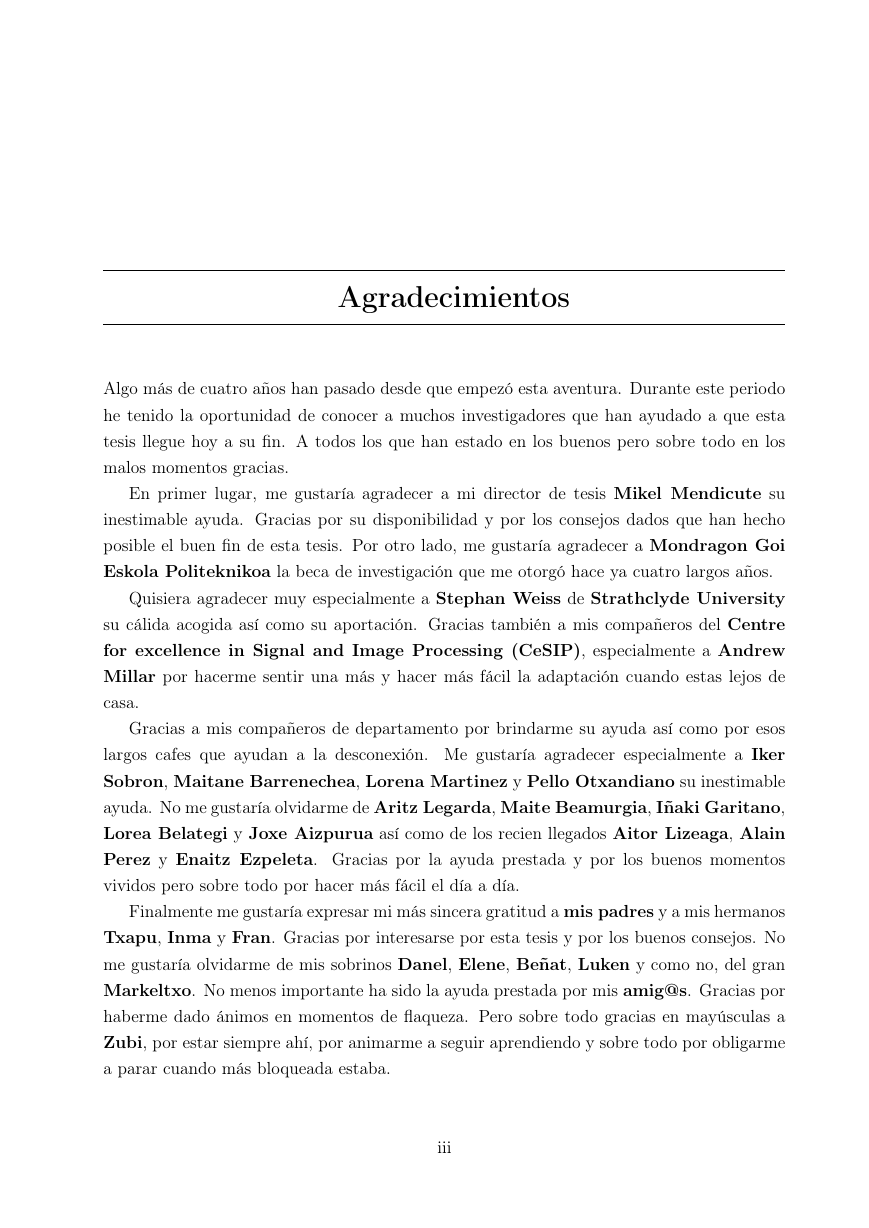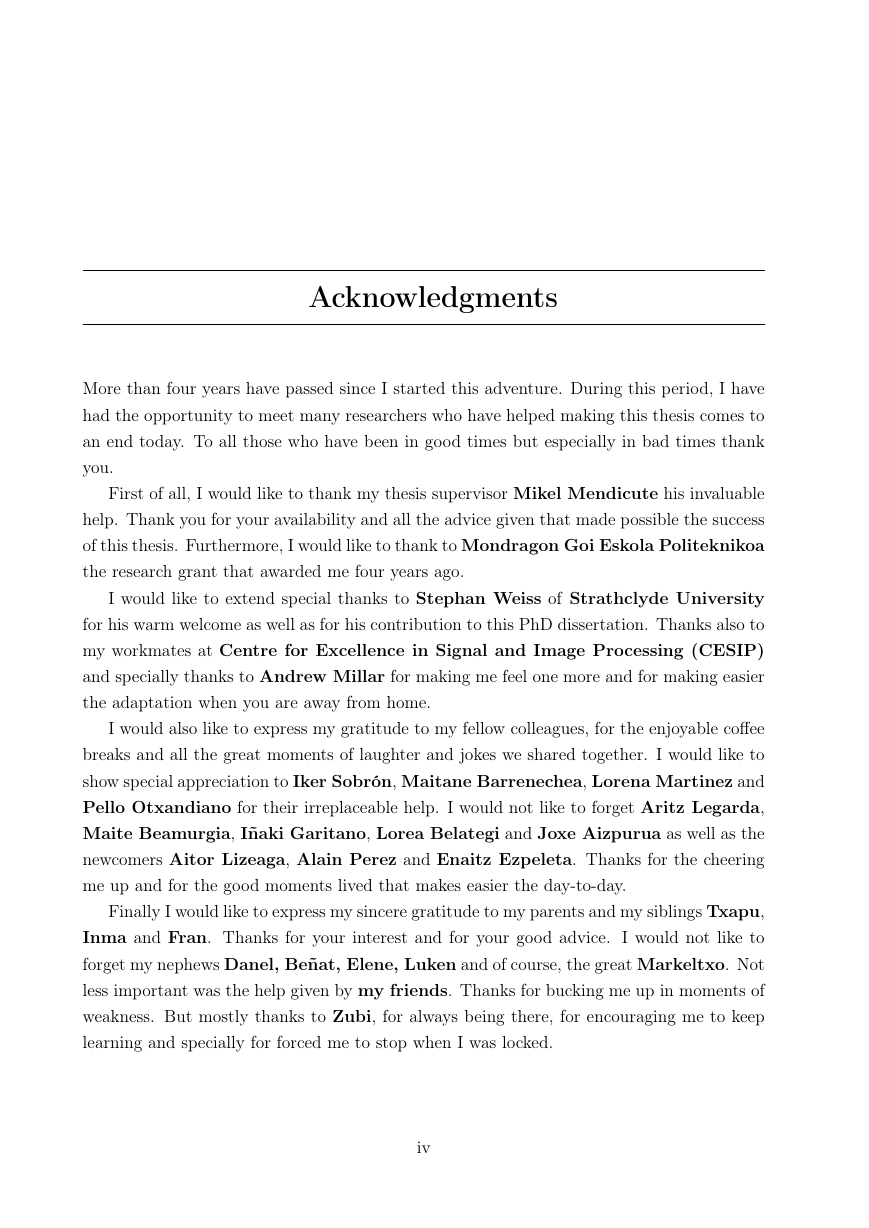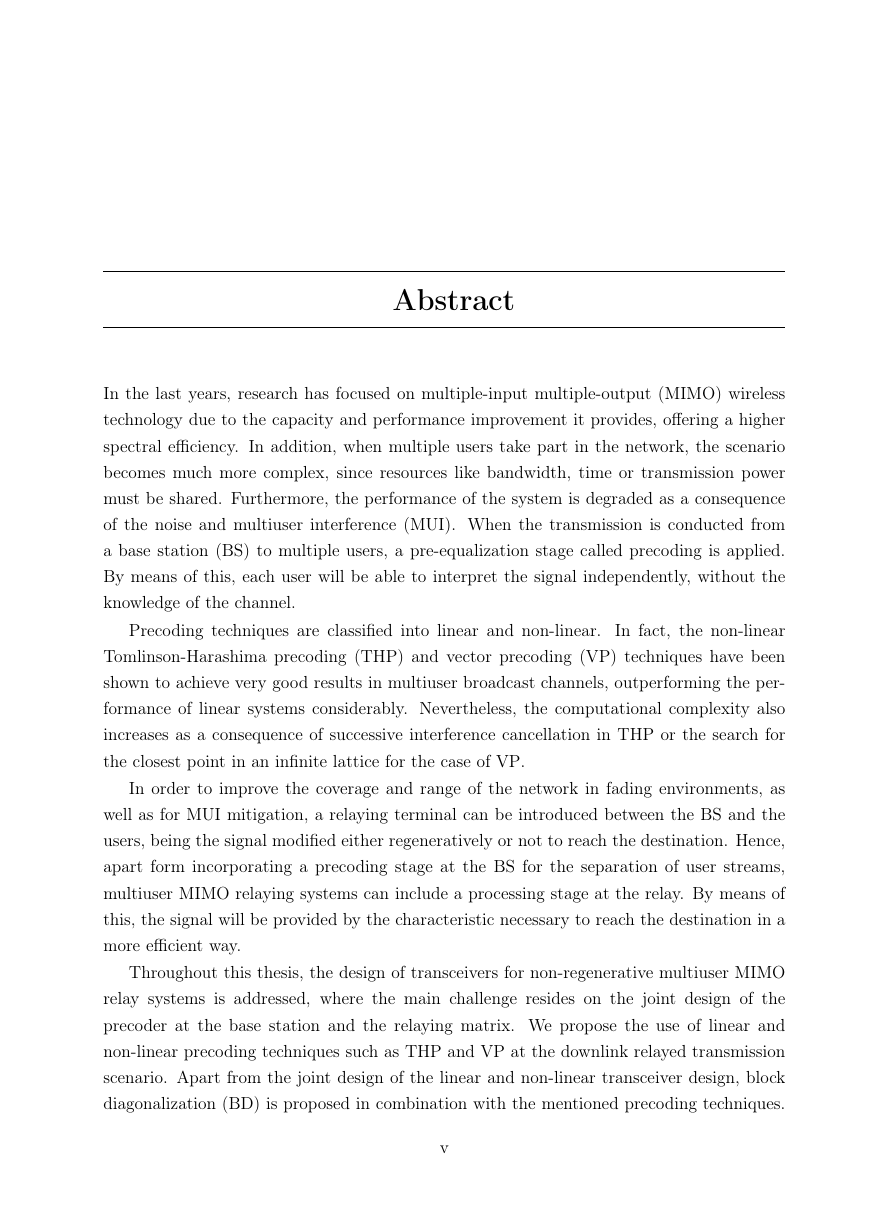Precoding and Relaying Algorithms for
Multiuser MIMO Downlink Channels
Idoia Jimenez Ramirez
Supervisor:
Mikel Mendicute Errasti
MONDRAGON
UNIBERTSITATEA
A thesis submitted for the degree of
Doctor por Mondragon Unibertsitatea
Department of Electronics and Computer Science
Mondragon Goi Eskola Politeknikoa
Mondragon Unibertsitatea
April 2013
�
�
Familixandako,
Ta Ionendako.
Learn from yesterday,
live for today,
hope for tomorrow.
The important thing is not to stop questioning.
Albert Einstein
�
�
Agradecimientos
Algo más de cuatro años han pasado desde que empezó esta aventura. Durante este periodo
he tenido la oportunidad de conocer a muchos investigadores que han ayudado a que esta
tesis llegue hoy a su fin. A todos los que han estado en los buenos pero sobre todo en los
malos momentos gracias.
En primer lugar, me gustaría agradecer a mi director de tesis Mikel Mendicute su
inestimable ayuda. Gracias por su disponibilidad y por los consejos dados que han hecho
posible el buen fin de esta tesis. Por otro lado, me gustaría agradecer a Mondragon Goi
Eskola Politeknikoa la beca de investigación que me otorgó hace ya cuatro largos años.
Quisiera agradecer muy especialmente a Stephan Weiss de Strathclyde University
su cálida acogida así como su aportación. Gracias también a mis compañeros del Centre
for excellence in Signal and Image Processing (CeSIP), especialmente a Andrew
Millar por hacerme sentir una más y hacer más fácil la adaptación cuando estas lejos de
casa.
Gracias a mis compañeros de departamento por brindarme su ayuda así como por esos
largos cafes que ayudan a la desconexión. Me gustaría agradecer especialmente a Iker
Sobron, Maitane Barrenechea, Lorena Martinez y Pello Otxandiano su inestimable
ayuda. No me gustaría olvidarme de Aritz Legarda, Maite Beamurgia, Iñaki Garitano,
Lorea Belategi y Joxe Aizpurua así como de los recien llegados Aitor Lizeaga, Alain
Perez y Enaitz Ezpeleta. Gracias por la ayuda prestada y por los buenos momentos
vividos pero sobre todo por hacer más fácil el día a día.
Finalmente me gustaría expresar mi más sincera gratitud a mis padres y a mis hermanos
Txapu, Inma y Fran. Gracias por interesarse por esta tesis y por los buenos consejos. No
me gustaría olvidarme de mis sobrinos Danel, Elene, Beñat, Luken y como no, del gran
Markeltxo. No menos importante ha sido la ayuda prestada por mis amig@s. Gracias por
haberme dado ánimos en momentos de flaqueza. Pero sobre todo gracias en mayúsculas a
Zubi, por estar siempre ahí, por animarme a seguir aprendiendo y sobre todo por obligarme
a parar cuando más bloqueada estaba.
iii
�
Acknowledgments
More than four years have passed since I started this adventure. During this period, I have
had the opportunity to meet many researchers who have helped making this thesis comes to
an end today. To all those who have been in good times but especially in bad times thank
you.
First of all, I would like to thank my thesis supervisor Mikel Mendicute his invaluable
help. Thank you for your availability and all the advice given that made possible the success
of this thesis. Furthermore, I would like to thank to Mondragon Goi Eskola Politeknikoa
the research grant that awarded me four years ago.
I would like to extend special thanks to Stephan Weiss of Strathclyde University
for his warm welcome as well as for his contribution to this PhD dissertation. Thanks also to
my workmates at Centre for Excellence in Signal and Image Processing (CESIP)
and specially thanks to Andrew Millar for making me feel one more and for making easier
the adaptation when you are away from home.
I would also like to express my gratitude to my fellow colleagues, for the enjoyable coffee
breaks and all the great moments of laughter and jokes we shared together. I would like to
show special appreciation to Iker Sobrón, Maitane Barrenechea, Lorena Martinez and
Pello Otxandiano for their irreplaceable help. I would not like to forget Aritz Legarda,
Maite Beamurgia, Iñaki Garitano, Lorea Belategi and Joxe Aizpurua as well as the
newcomers Aitor Lizeaga, Alain Perez and Enaitz Ezpeleta. Thanks for the cheering
me up and for the good moments lived that makes easier the day-to-day.
Finally I would like to express my sincere gratitude to my parents and my siblings Txapu,
Inma and Fran. Thanks for your interest and for your good advice. I would not like to
forget my nephews Danel, Beñat, Elene, Luken and of course, the great Markeltxo. Not
less important was the help given by my friends. Thanks for bucking me up in moments of
weakness. But mostly thanks to Zubi, for always being there, for encouraging me to keep
learning and specially for forced me to stop when I was locked.
iv
�
Abstract
In the last years, research has focused on multiple-input multiple-output (MIMO) wireless
technology due to the capacity and performance improvement it provides, offering a higher
spectral efficiency. In addition, when multiple users take part in the network, the scenario
becomes much more complex, since resources like bandwidth, time or transmission power
must be shared. Furthermore, the performance of the system is degraded as a consequence
of the noise and multiuser interference (MUI). When the transmission is conducted from
a base station (BS) to multiple users, a pre-equalization stage called precoding is applied.
By means of this, each user will be able to interpret the signal independently, without the
knowledge of the channel.
Precoding techniques are classified into linear and non-linear.
In fact, the non-linear
Tomlinson-Harashima precoding (THP) and vector precoding (VP) techniques have been
shown to achieve very good results in multiuser broadcast channels, outperforming the per-
formance of linear systems considerably. Nevertheless, the computational complexity also
increases as a consequence of successive interference cancellation in THP or the search for
the closest point in an infinite lattice for the case of VP.
In order to improve the coverage and range of the network in fading environments, as
well as for MUI mitigation, a relaying terminal can be introduced between the BS and the
users, being the signal modified either regeneratively or not to reach the destination. Hence,
apart form incorporating a precoding stage at the BS for the separation of user streams,
multiuser MIMO relaying systems can include a processing stage at the relay. By means of
this, the signal will be provided by the characteristic necessary to reach the destination in a
more efficient way.
Throughout this thesis, the design of transceivers for non-regenerative multiuser MIMO
relay systems is addressed, where the main challenge resides on the joint design of the
precoder at the base station and the relaying matrix. We propose the use of linear and
non-linear precoding techniques such as THP and VP at the downlink relayed transmission
scenario. Apart from the joint design of the linear and non-linear transceiver design, block
diagonalization (BD) is proposed in combination with the mentioned precoding techniques.
v
�
BD, which maps each user signal at the null space created by the interfering users, is applied
at the relay for interference cancellation whilst linear processing and VP are set at the BS
for users signal separation and overall error minimization.
The main contributions of this research work are the novel optimal proposals based on
non-linear precoding techniques and the consideration of BD for the joint design. Fur-
thermore, simple and computationally efficient suboptimal approaches based on linear and
non-linear precoding techniques are first here proposed. In addition, block diagonal geomet-
ric mean decomposition is presented in combination with VP for the optimal and suboptimal
design of the transmitter. To conclude, a complete complexity analysis is given in order to
show the effectiveness of the proposed schemes.
�
















 2023年江西萍乡中考道德与法治真题及答案.doc
2023年江西萍乡中考道德与法治真题及答案.doc 2012年重庆南川中考生物真题及答案.doc
2012年重庆南川中考生物真题及答案.doc 2013年江西师范大学地理学综合及文艺理论基础考研真题.doc
2013年江西师范大学地理学综合及文艺理论基础考研真题.doc 2020年四川甘孜小升初语文真题及答案I卷.doc
2020年四川甘孜小升初语文真题及答案I卷.doc 2020年注册岩土工程师专业基础考试真题及答案.doc
2020年注册岩土工程师专业基础考试真题及答案.doc 2023-2024学年福建省厦门市九年级上学期数学月考试题及答案.doc
2023-2024学年福建省厦门市九年级上学期数学月考试题及答案.doc 2021-2022学年辽宁省沈阳市大东区九年级上学期语文期末试题及答案.doc
2021-2022学年辽宁省沈阳市大东区九年级上学期语文期末试题及答案.doc 2022-2023学年北京东城区初三第一学期物理期末试卷及答案.doc
2022-2023学年北京东城区初三第一学期物理期末试卷及答案.doc 2018上半年江西教师资格初中地理学科知识与教学能力真题及答案.doc
2018上半年江西教师资格初中地理学科知识与教学能力真题及答案.doc 2012年河北国家公务员申论考试真题及答案-省级.doc
2012年河北国家公务员申论考试真题及答案-省级.doc 2020-2021学年江苏省扬州市江都区邵樊片九年级上学期数学第一次质量检测试题及答案.doc
2020-2021学年江苏省扬州市江都区邵樊片九年级上学期数学第一次质量检测试题及答案.doc 2022下半年黑龙江教师资格证中学综合素质真题及答案.doc
2022下半年黑龙江教师资格证中学综合素质真题及答案.doc